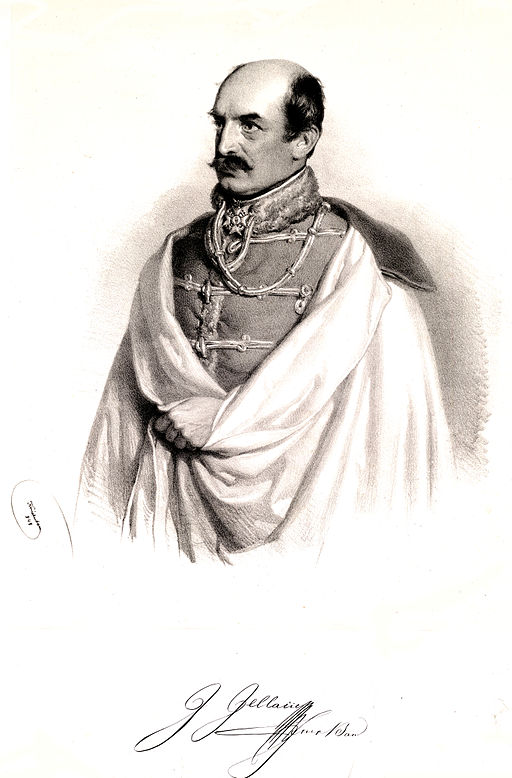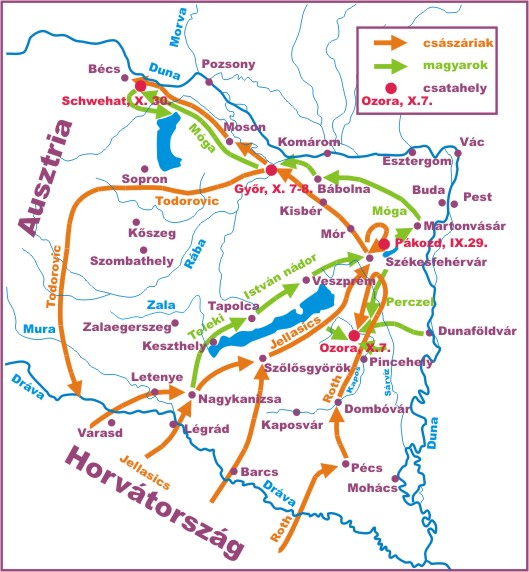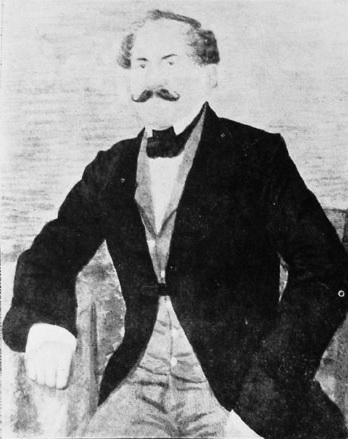The victory of Pákozd – a symbol of Hungary’s independence war

175 years ago, on 29 September 1848, the Battle of Pákozd, one of the most important battles of the 1848/49 Revolution and War of Independence, took place. On this day, the newly formed Hungarian army clashed with the troops led by Croatian Ban Jellačić in the Pákozd-Sukoró area. The stakes of the clash were whether the army attacking Hungary could be repulsed, creating the opportunity to organise military resistance.
No chance to make peace between Habsburgs and Hungary
By July 1848, the process of Hungarian independence had reached a stage where the Habsburg court no longer dared to face the possible consequences of its elimination by open military attack. In any case, the Batthyány government was scrupulously careful not to give Vienna any reason to attack. The Habsburgs, therefore, wanted to use anti-Hungarian nationalist movements to achieve their goals. The nationalities living in Hungary had already made demands on the Hungarian government in the spring, but these had always been rejected by the Batthyány government. The Habsburg court recognised the potential of this situation and began to secretly send money, weapons and military supplies, especially to the Croatian ban (provincial governor) Josip Jellačić, who was preparing to invade Hungary.
Jellačić’s attack
Jellačić was an opponent of the Hungarian revolution. This, and the fact that he received military training, qualified him to play a key role in the Habsburg attack on the Hungarian uprising. The ban openly prepared for an armed attack on Hungary, the first step of which was the invasion of the important breeding town of Fiume on 31 August. The Hungarian government, led by Prime Minister Lajos Batthyány, wanted to avoid the clash and asked for a meeting with Ferdinand V. The emperor did not receive the Hungarian government delegation, but confirmed Jellačić as Ban on 4 September. On 11 September, Jellačić’s army crossed the Drava with about thirty-five thousand men.

Jellačić addressed a manifesto to the Hungarian people in which he made it clear that he had come to suppress the revolutionary movement of “rebels” in Hungary, and to defend the Monarchy. Officially, the imperial forces in Hungary were under the command of the Minister of War, Lázár Mészáros, and a large number of his officers took an oath to the Hungarian constitution on royal orders.
The leader of the Hungarian army, Major General Count Ádám Teleki, found himself in a delicate position. Their oath to the Hungarian constitution and their patriotic spirit would have justified armed resistance. But the battle was essentially to be waged against the imperial troops. Therefore, in order to avoid a direct clash, the Hungarian army began to retreat towards Székesfehérvár.
In the meantime, various measures were taken with feverish speed to strengthen the Hungarian army and organise its defence. As a result of these efforts, the main Hungarian force had grown to about sixteen thousand men in the last days of September. They had succeeded in taking up a defensive position north of Lake Velence. His former retreat manoeuvre the Hungarian government lost its confidence in Teleki as well as the military leadership, they appointed the new army commander, Lieutenant General János Móga.
The course of the battle
The Hungarian troops took the position that the roads leading to the capital should be closed. It is interesting to note that the Battle of Pákozd was fought by imperial and royal officers on both sides.
Read also: The world’s tallest hussar statue inaugurated in Pákozd
Jellačić’s plan, judging by the manoeuvres he carried out, was to smash the right flank of the Hungarian army or push it into the centre and then destroy the entire Hungarian army by a frontal attack and push it into Lake Velence.

It turned out to be a failure, Jellačić launched an attack with his main force of 20,000 men against the Hungarian centre and left flank around twelve noon, but repeated infantry and cavalry attacks were knocked down each time by fire from the Hungarian units.
There was practically no close combat. Jellačić stopped the fighting around 3 p.m. The artillery duel continued into the evening, but Jellačić gradually withdrew his troops and called for a ceasefire.
The victory over Jellačić was completed by the Hungarian National Guard forcing Jellačić’s reserve corps to surrender at the Battle of Ozora on 7 October.
When considering the number of participants, the number casualties were not high: there were about 45-50 dead on both sides, the Croats had 120 wounded, the Hungarians had at least 40. The Hungarian artillery was completely superior to that of the Croats. The Croatian cavalry did not have to face fire, and Hungarian hussars took part in close combat only in the right wing against Croatian infantry.
The performance of the Croatian general staff was poor, one of the divisions of the Croatian forces did not even arrive in the battlefield. the Hungarian commander-in-chief, János Móga, defended their position with about 10,000 men and repelled an enemy three and a half times bigger in number.

Consequences
The battle is not one of the great battles of the War of Independence, but its consequences are invaluable for the survival of the Hungarian independence struggle. Apart from the significant military outcomes, the victory became a symbol of Hungarian defence. The triumph not only lifted the spirit of the Hungarian army, but also was an important factor in the causes of the revolution that broke out in Vienna on 6 October.
Read also: The 1848-’49 Hungarian Revolution and Freedom Fight ended 170 years ago
Source:






Hungary won its independence with enormous sweat and blood, multiple times even just in the past couple hundred years. It must not fritter it away to the globalist-socialist E.U., U.N., etc. cabal.
Interesting history, Hungary has a lot to be proud of from their history. They should deeply condemn other countries who falsify their history in their school text books.
As a side note: Most countries in Europe have gone through similar wars and gained their independent though sweat and blood. And still most European countries have been able to modernize their societies and introduce democracies where diversity is respected and understood and mass media and other business areas are not controlled by a single political party – and these countries are also thriving and citizens are mostly happy – much happier than Hungarians in general which is verified by all independent surveys, unfortunately. You can force many things on you citizens, but not happiness.